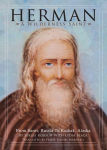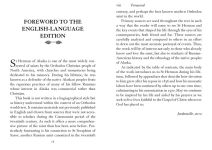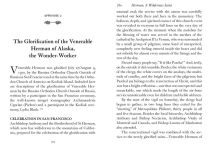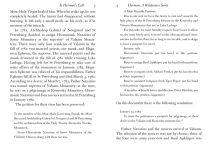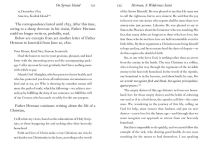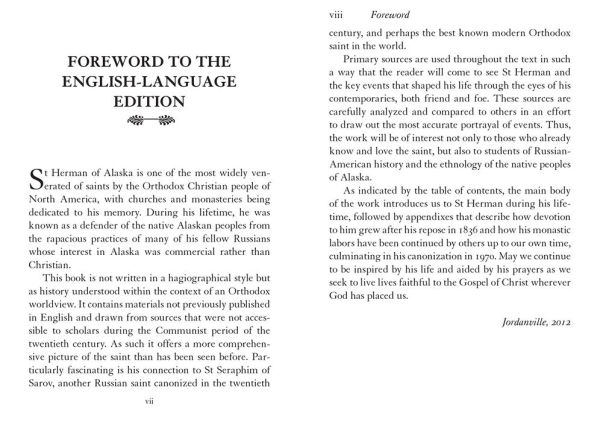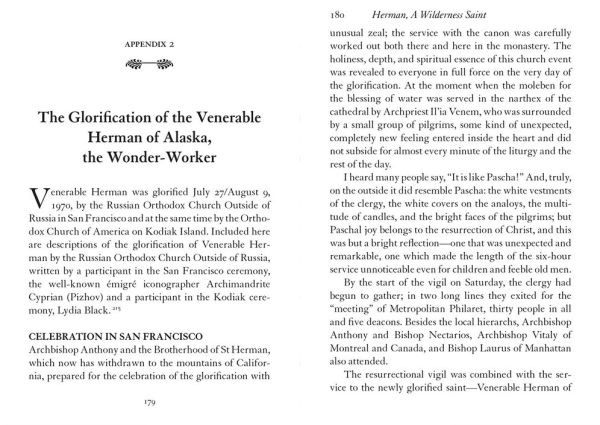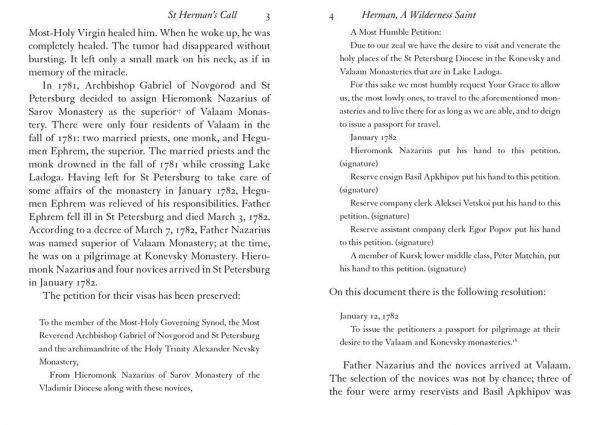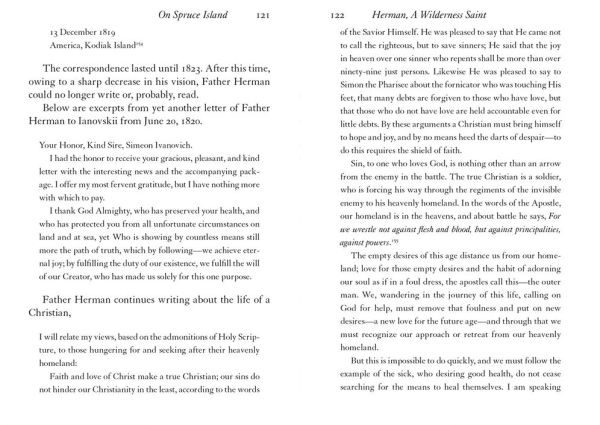Since his canonization in 1970, St. Herman has been remembered for his just treatment of native peoples and his respect of the environment. Explaining how it came to be that this simple Russian Orthodox monk eventually settled in Kodiak, Alaska, this account brings to light many primary sources that illuminate the story of St. Herman and the wider context of the little-known history of Russian colonization in the Pacific Northwest. Providing a considerable amount of new information about his life, this book also reveals his fascinating connection to St. Seraphim of Sarov, the most universally recognized saint of the Russian Orthodox Church today.
Since his canonization in 1970, St. Herman has been remembered for his just treatment of native peoples and his respect of the environment. Explaining how it came to be that this simple Russian Orthodox monk eventually settled in Kodiak, Alaska, this account brings to light many primary sources that illuminate the story of St. Herman and the wider context of the little-known history of Russian colonization in the Pacific Northwest. Providing a considerable amount of new information about his life, this book also reveals his fascinating connection to St. Seraphim of Sarov, the most universally recognized saint of the Russian Orthodox Church today.

Herman: A Wilderness Saint: From Sarov, Russia to Kodiak, Alaska
260
Herman: A Wilderness Saint: From Sarov, Russia to Kodiak, Alaska
260Paperback
-
SHIP THIS ITEMIn stock. Ships in 2-4 days.PICK UP IN STORE
Your local store may have stock of this item.
Available within 2 business hours
Related collections and offers
Overview
Since his canonization in 1970, St. Herman has been remembered for his just treatment of native peoples and his respect of the environment. Explaining how it came to be that this simple Russian Orthodox monk eventually settled in Kodiak, Alaska, this account brings to light many primary sources that illuminate the story of St. Herman and the wider context of the little-known history of Russian colonization in the Pacific Northwest. Providing a considerable amount of new information about his life, this book also reveals his fascinating connection to St. Seraphim of Sarov, the most universally recognized saint of the Russian Orthodox Church today.

Product Details
| ISBN-13: | 9780884651925 |
|---|---|
| Publisher: | Holy Trinity Publications |
| Publication date: | 10/12/2012 |
| Pages: | 260 |
| Product dimensions: | 4.90(w) x 7.70(h) x 0.40(d) |
About the Author
Sergei Korsun is the chief specialist in the department of America at the Peter the Great Museum of Anthropology and Ethnography in St. Petersburg, Russia. Lydia Black was an American anthropologist and historian. She was a professor at the University of Alaska and an employee of the St. Herman Orthodox Theological Seminary. She was the recipient of the Order of Friendship Medal form the Russian Federation and the author of several books, including The Journals of Iakov Netsvetov: The Yukon Years, 1845–1863, Russians in Alaska, 1732–1867, and Russians in Tlingit America. Born in Kiev, Ukraine, she spent much of her life in Alaska. Daniel Marshall is the rector of the Holy Protection of the Virgin Mary Orthodox Church in Goshen, Indiana. A Russian-language translator, he is also the author of St. Seraphim's Beatitudes: Blessings for Our Path to Heaven. He lives in Middlebury, Indiana.
Read an Excerpt
Herman A Wilderness Saint
From Sarov, Russia to Kodiak, Alaska
By Sergei Korsun, Lydia Black, Priest Daniel Marshall
Holy Trinity Publications
Copyright © 2012 Holy Trinity MonasteryAll rights reserved.
ISBN: 978-0-88465-192-5
CHAPTER 1
St Herman's Call: From Sarov to Valaam Monastery
St Herman of Alaska's biography should begin with Ferdinand Peterovich Wrangell's evidence that identifies St Herman as Egor Ivanovich Popov. He was born in 1751 in a village of the Voronezh province to a very pious peasant family. It is known that one of his relatives finished her days as a nun of the famous Strastnoi Monastery in Moscow.
From his early childhood, the young Egor possessed a great zeal for piety; he went on many pilgrimages to Sarov Monastery. For some period of time, he lived in the forest of Sarov Monastery in the cell of the elder Varlaam (1764), who was the spiritual father of Father Nazarius, the future abbot of Valaam Monastery. In 1778, Egor Ivanovich Popov became a novice at the Sarov Monastery. Little is known about this period in his life. It is clear that before he entered the monastery, he served as junior clerk in the military command of the city of Kadom. Also, he knew the monk Theophan, who in 1771 became a novice in Sanaksarskii Monastery, which is located not far from Sarov. Theophan later became an archimandrite and the superior of the Kyrillo-Novozerskii Monastery. From 1782 to 1791, Theophan served as cell attendant for Metropolitan Gabriel of Novgorod and St Petersburg.
Remembering Father Herman, Archimandrite Theophan wrote, "Father Herman (he is now in America) from the earliest years lived in the forest with Father Varlaam. Once Father Varlaam had to depart and left the youth — he was 12 years old — alone. Those who were gathering mushrooms in the woods lost their way and came across a cell of hermits. When he entered their cell, they were afraid of him, since his presence in the forest seemed so unusual to them."
In his youth, Egor was seriously ill. A tumor formed on his throat that grew quickly and deformed his entire face. The pain was terrible; it was difficult to swallow. The tumor gave off an unbearable odor. Despite this, he did not go to the doctor, but with heartfelt prayer and tears of repentance he fell down before an icon of the Mother of God and began to ask God for healing. He prayed all night, after which he wiped the face of the Most-Holy Mother of God with a wet cloth and then used it to wrap the tumor. Continuing to pray, Egor fell asleep on the floor from exhaustion and saw in a dream that the Most-Holy Virgin healed him. When he woke up, he was completely healed. The tumor had disappeared without bursting. It left only a small mark on his neck, as if in memory of the miracle.
In 1781, Archbishop Gabriel of Novgorod and St Petersburg decided to assign Hieromonk Nazarius of Sarov Monastery as the superior of Valaam Monastery. There were only four residents of Valaam in the fall of 1781: two married priests, one monk, and Hegumen Ephrem, the superior. The married priests and the monk drowned in the fall of 1781 while crossing Lake Ladoga. Having left for St Petersburg to take care of some affairs of the monastery in January 1782, Hegumen Ephrem was relieved of his responsibilities. Father Ephrem fell ill in St Petersburg and died March 3, 1782. According to a decree of March 7, 1782, Father Nazarius was named superior of Valaam Monastery; at the time, he was on a pilgrimage at Konevsky Monastery. Hieromonk Nazarius and four novices arrived in St Petersburg in January 1782.
The petition for their visas has been preserved:
To the member of the Most-Holy Governing Synod, the Most Reverend Archbishop Gabriel of Novgorod and St Petersburg and the archimandrite of the Holy Trinity Alexander Nevsky Monastery,
From Hieromonk Nazarius of Sarov Monastery of the Vladimir Diocese along with these novices,
A Most Humble Petition:
Due to our zeal we have the desire to visit and venerate the holy places of the St Petersburg Diocese in the Konevsky and Valaam Monasteries that are in Lake Ladoga.
For this sake we most humbly request Your Grace to allow us, the most lowly ones, to travel to the aforementioned monasteries and to live there for as long as we are able, and to deign to issue a passport for travel.
January 1782
Hieromonk Nazarius put his hand to this petition. (signature)
Reserve ensign Basil Apkhipov put his hand to this petition. (signature)
Reserve company clerk Aleksei Vetskoi put his hand to this petition. (signature)
Reserve assistant company clerk Egor Popov put his hand to this petition. (signature)
A member of Kursk lower middle class, Peter Matchin, put his hand to this petition. (signature)
On this document there is the following resolution:
January 12, 1782
To issue the petitioners a passport for pilgrimage at their desire to the Valaam and Konevsky monasteries.
Father Nazarius and the novices arrived at Valaam. The selection of the novices was not by chance; three of the four were army reservists and Basil Apkhipov was even an officer, an ensign. They had already mastered discipline and the careful carrying out of their superior's orders, even in the world. Father Nazarius alone served the services on Valaam for about a year, because there were no other hieromonks there. In November 1782, the novices E. I. Popov and P. Matchin were tonsured into monasticism. The report of their tonsures follows:
To the Most-Holy Governing Synod
A Report
After the decree of Her Majesty from the Most-Holy Governing Synod of October 22 of this year which was sent to me, the assistant company clerk Egor Popov and the member of the Kursk lower middle class Peter Matchin, who are among the brotherhood of the Spaso-Preobrazhenskii Valaam Monastery, were tonsured 1 November and named: Popov — Herman, Matchin — Patermufii, as is stated in the report sent by the superior of that monastery and about which I most respectfully report to the Most-Holy Governing Synod.
The obedient servant of Your Majesty
Gabriel, Archbishop of Novgorod
After a visit to Valaam Monastery in 1785, the academic N. Ia. Ozertskovskii wrote the following vivid description of this monastery and the life of its residents.
In general the location of the monastery is quite beautiful, and, it can said, majestic, but the monastery structures do not correspond to the location in the least. They consist of a wooden fence, inside of which are the church with its bell tower and small monastery huts, which are also wooden. But during my stay there they began to build from stone both a church and monastic cells. ... The current hermits lead a labor-loving life. The slightest disagreement is not seen in their community, which consists of at least twenty people. They possess nothing as individuals; instead they own everything together. But most commendable of all is their sobriety. ... There is no other settlement on the entire island of Valaam, except for the monastery. In various places only huts exist, deliberately situated for the greater solitude of the Valaam hermits, some of whom withdraw from their brothers to the huts and live there for several weeks or months at a time. The places chosen for these retreats are only the most beautiful ones where the vista encompasses a pleasant view of trees, plants, stone cliffs, and valleys, and where the soul is fed by the meditations to which silence and solitude give birth.
With an adequate supply of all that is necessary for life and while living in complete silence and tranquility, these hermits lead a blessed life and have compelling reason to conduct themselves according to their calling. In fairness, it is impossible not to give them credit for this, since they are well behaved and conduct the cycle of services every day. They all eat lunch and dinner together; moreover, they typically observe absolute silence, for the keeping of which one of the brotherhood stands and reads loudly and clearly from some religious book while the brothers eat. Their diet typically consists of cabbage soup, fish soup, and meal. They do not dish these liquids into bowls, but instead scoop them up with wooden spoons from large wooden bowls; they do not hold napkins for cleaning up. ... At meals, the youngest waits upon them. At the end of the meal, they all read a prayer out loud together and depart for their cells. There they practice various handiwork, such as turning maple spoons, carving cypress crosses, and the like, while in the summer they work in vegetable gardens, till the soil, harvest wheat, and cut hay. The superior, Nazarius, participates in all these jobs with the others.
Under the leadership of Father Nazarius, Valaam Monastery was transformed. The old wooden structures were replaced with stone ones. The Dormition Church was built of stone in 1785; in 1793, St Nicholas Church; and in 1794, the Transfiguration Church along with its bell tower and the skete with the Church of All Saints. The brotherhood of the Novgorod Dukhovnii monastery was transferred to Valaam in 1786; their former monastery became a convent. In that same year, Valaam Monastery was added to the list of established monasteries of the third class with hegumen superiors, and its superior, Father Nazarius, was raised to the rank of hegumen.
Father Varlaam, a contemporary of Father Herman's who later became superior of Valaam, recalled this about the life of the saint at Valaam: "Father Herman undertook various obediences here and, by the way, as 'one ready for any good deed,' was sent to the town of Serdobol' to supervise the granite quarrying there. The brothers loved Father Herman and anxiously awaited his return from Serdobol' to the community."
Despite the fact that Valaam was a very strict monastery, the soul of Father Herman sought solitude, and, after experience in various obediences, Father Nazarius released him to live in a hermitage.
The book Valaam Monastery and Its Ascetics, published in 1899, describes the hermits:
As far as those Valaam monks are concerned — those who have received a blessing from the monastery leadership to seek their salvation in hermitages due to the trustworthy testimony of their lives — these strict ascetics, instead of attending daily divine services, continually practice prayer in their cells, especially the prayer of the mind. They keep a monastic prayer rule as prescribed by ancient statutes. For the maintenance of their life and strength, they are content with the most meager food, which they prepare themselves.
The hermits, like the skete-dwellers, come to the monastery on great feast days regardless of the kind of weather. There they are lovingly received by the brothers, participate with them in the common services, and share in a meal.
The quantity and state of the prayer of the hermits, as ones already experienced in the spiritual life, depends entirely on the degree of their strength and the internal movements of their soul. These elements, however, are dependably checked by the prudent sense and conscience of the superior or spiritual father of those being guided, since this is a priest's responsibility, and is confirmed by the hermits' way of life. Therefore the hermits' service to God is concealed, like their lives. But they are hidden, according to scripture, "with Christ in God" (Col 3:3).
The hermitage, which Father Herman chose for himself, was located in a deep forest, a little more than a mile from the monastery. That place is called "Herman's field" to this day. Father Herman lived alone in the hermitage for a period of time, and subsequently he lived with the young novice Kuz'ma Alekseevich Telepnev, just as he had lived in his youth at Sarov Monastery in the cell of elder Varlaam. In 1793, at the time of his departure from Valaam, Father Herman was forty-two years old, and the novice K. A. Telepnev was twenty years old. On holidays, Father Herman would walk from the hermitage to the monastery. Tears would pour from his eyes during small vespers while standing on the kliros and singing along with the brothers the refrains of the canon: "O sweetest Jesus, save us sinners" and "O most holy Mother of God save us."
Judging by their letters, Father Herman personally knew Metropolitan Gabriel of Novgorod, St Petersburg, and Olonets when he was a ruling hierarch of the Russian Orthodox Church. By 1793, Father Herman had been invited to be ordained as a priest-monk and even to be made archimandrite and head of the Russian Orthodox mission in Peking. It was again suggested that he become a priest-monk in 1808, but "he did not want to be an archimandrite, understanding well that with every elevation he would be more and more bound and further and further from his favorite occupation: to praise God as a hermit!"
Father Herman spent ten years in Valaam Monastery in the unceasing ascetic struggles of fasting and prayer, but it would become more pleasing to God that he serve at the other end of the earth — in Alaska — among a people who had not yet come to know the true faith.
CHAPTER 2Missionary Service in Alaska
ORGANIZATION OF THE ORTHODOX MISSION IN AMERICA
Alaska was discovered in 1741 by the Russian sailors Vitus Jonassen Bering and A. I. Chirikovii. The economic development of this territory began in 1745 in the Aleutian chain. Beginning in the 1780s, several trading and trapping companies won monopolies from the government for the exploitation of Alaska. One of them was headed by the merchants Ivan Larionovich Golikov and Grigorii Ivanovich Shelikhov. In 1784, Shelikhov set out for Alaska, where he stayed until 1786. He founded a permanent settlement on Kodiak Island, subjugating the local population to himself. Shelikhov transferred to Siberia fifteen residents of Kodiak and the regions near it. Two of them, Alakhan and Kiiak, were lodged in Golikov's house in Kursk. They were baptized in 1789.
The petition of Alakhan and Kiiak "to join the Orthodox Greek-Russian Church" notes that "we, the undersigned, were born in the very distant, recently discovered American territory, one of us on an island and the other on the mainland. We lived like the wild peoples who reside there, not knowing any faith or law and not having the least understanding of any Divinity; we grew up in complete ignorance of the true God." In baptism, Alakhan was named Peter and Kiiak, Paul. Both Americans subsequently continued to live in Kursk and to serve Golikov.
In 1789, Metropolitan Gabriel decided to send two monks to serve in America. The two chosen for this purpose were the monk Iakov, for whom there are no records of the monastery in which he lived, and Hieromonk Joachim from Sarov Monastery. "But this one [Joachim], who loved Sarov monastery and the spiritual poverty of simple monasticism, began to decline such an appointment, and even acted as a 'fool-for-Christ' for several years in order to avoid such an honor."
Having received this news from abbot Pakhomii of Sarov monastery, Metropolitan Gabriel wrote,
Having read your letter, I was shocked. Father Joachim, who is worthy of Christian love, behaves this way, as you write, in order to save himself. But he who does not want to aid in the salvation of others, is not saving himself.
Humility, which he always preserves in his soul, will rise up, when, having been called to the salvation of many, he will be like a slave and servant.
I ask you to admonish him in the name of Jesus Christ, who took the sins of the entire world, that he follow in His footsteps. He came into the world to a throng of corrupt people, so that He could save them. Surely he does not think this example is not worthy of imitation? Does he say that we have no strength and are weak? The Apostle Paul said this, but then he confessed: "yet not I, but the grace of God which was with me" (1 Cor 15:10).
Christ is calling him; grace awaits him, so that he can work with it. Let him consider, what a great transgression this is — to make your ears deaf to the call of Jesus Christ.
At this time, the idea to send monks to serve in America did not come to fruition.
In 1793, Golikov and Shelikov personally appealed to the Most-Holy Synod with a petition in which they asked to send "a good priest with the necessary assistants" to America. The ober-procurator of the synod made a report to Catherine II, who ordered that not one priest but a whole Orthodox mission be sent to America.
Metropolitan Gabriel of Novgorod, St Petersburg, and Olonets was entrusted with creating the mission. Metropolitan Gabriel, knowing the ascetic life of the Valaam elders, their unshakable devotion to Orthodoxy, and readiness to undertake any labor in the name of God, charged Hegumen Nazarius to select a few monks to fulfill this very important obedience. Monk Herman immediately volunteered to go to America. Hegumen Nazarius assigned a total of six monks and four novices to the mission. Archimandrite Joseph headed the mission. Subordinate to him were Hieromonks Juvenaly, Macarius, and Athanasius; Hierodeacon Nectarios and monk Herman; and the four novices Kuz'ma Alekseevich Telepnev, Michael Fedorovich Govorukhin, Nikita Semenov, and Dmitry Avdeev. Only a little is known about their lives before they arrived in America.
(Continues...)
Excerpted from Herman A Wilderness Saint by Sergei Korsun, Lydia Black, Priest Daniel Marshall. Copyright © 2012 Holy Trinity Monastery. Excerpted by permission of Holy Trinity Publications.
All rights reserved. No part of this excerpt may be reproduced or reprinted without permission in writing from the publisher.
Excerpts are provided by Dial-A-Book Inc. solely for the personal use of visitors to this web site.
Table of Contents
Contents
Foreword to the English-Language Edition,Introduction,
1. St Herman's Call: From Sarov to Valaam Monastery,
2. Missionary Service in Alaska,
Organization of the Orthodox Mission in America,
First Year on Kodiak Island,
Life and Ascetic Labors of the Missionaries,
Father Herman Takes Charge of the Kodiak Mission,
3. On Spruce Island: A Saint in the Wilderness,
4. Father Herman's Repose and His Legacy,
Appendix 1: The Fate of New Valaam,
Appendix 2: The Glorification of the Venerable Herman of Alaska, the Wonder-Worker,
Appendix 3: Eyewitnesses,
Notes,
Index,
